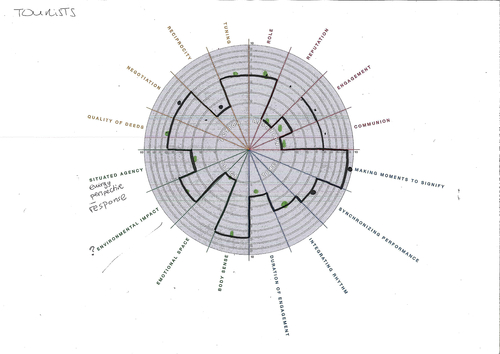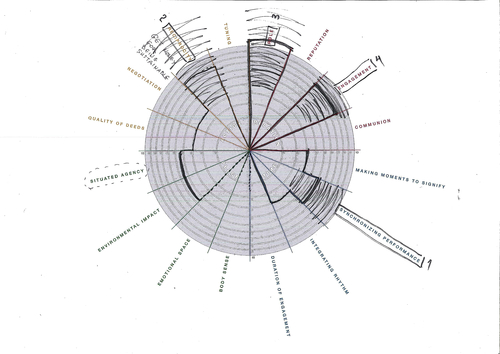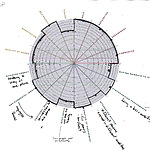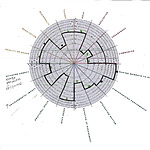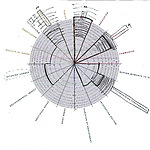"The YUTPA framework, acronym for being with You in unity of Time, Place and Action, sheds light on specific presence configurations in which a person performs presence with YOU, in the NOW, being HERE, with a specific potential to DO certain things." (Nevejan 2014)
In YUTPA analysis we are called to realize the value of a design in relation with the presence of a person that experiences the space where the design will be implemented and therefore his survival and wellbeing are affected on certain levels. These levels are placed around the YUTPA analysis circle as following:
The circle is divided in the four sectors of Relation, Time, Place and Action.
Let’s give a short description about the different dynamics involved in this circle. The two main teams of people that we have to think about are the residents of Texel and the tourists that visit the island, mainly for recreation purposes.
Relation is based on the combination of role, reputation, engagement and communion. The residents and the tourists behave very differently towards these values. Imagining that the mobility system is a common network that all the actors use, every actor has a role in it and apparently is engaged with the mobility system. Therefore, this part of the circle is important, if we want to redefine the way the mobility system works.
Time is about making moments to signify, synchronizing performance, integrating rhythm, duration of engagement. For all the people the moments to signify are important. However, for the system of mobility this value does not have much to add. On the other hand the synchronizing performance is very important for a time mobility network that saves time. Moreover, the integrating rhythm depends both on the personality of someone, but also the length of time that someone experiences a place. Nevertheless, if a mobility system is well organized it can be used efficiently also by new users. The duration of engagement of a person to Texel place could mean that the person will potentially be very eager in contributing in a sustainable mobility system. On the other hand, sometimes it is easier to convince people that are new in an area to adopt new habits, rather than old residents.
Place is analysed in body sense, emotional space, environmental impact and situated agency. As transportation is an important part of our day, unavoidably it influences the body sense. Next to this it has impact on the environment. The body sense factor is related to the character of the person and the physical condition. Ideally someone could say that a mobility system based on collective transport and cycling would lead the body sense feeling to very high levels.
To end up with, the value of Action includes tuning, reciprocity, negotiation, quality of deeds. The action that a local can take within the communion, the possibility for discussion, within an adaptable system, that also provides its citizens with incentives, are parameters that speak to every local’s mind. Especially for the mobility aspect, as the mobile transport is a matter of personal choice, every person can contribute in the development of sustainable mobility in Texel. It is not only about creating new infrastructures. It is mainly about changing the established habits.
As it can easily be derived by a short analysis of a person’s behaviour, the four parts of the circle are interconnected as, for example, the time that you are engaged with a place affects your relation and action within the society and the certain aspects of it.
The idea is to collect the values given by the different actors on these dynamics of the system according to our perceptions. When putting together the different perspectives, the discrepancies in how the different actors perceive the system are seen and from this, a design space can be elaborated.
YUTPA Analysis for locals on the island
YUTPA Diagram for locals
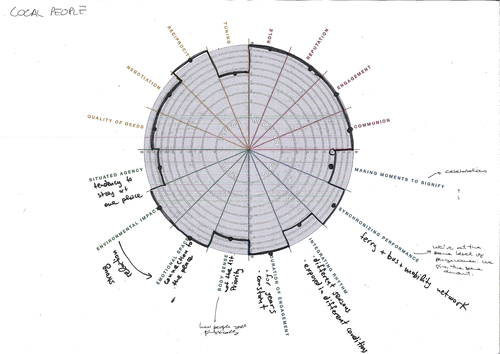
The relation of the locals with the community in which they live and consequently interact is of a great importance for them. Especially in relevantly small societies, like Texel, where nature is the predominant characteristic and the population is distributed in small villages. Texelars have been engaged to this beautiful land, for quite some time (potentially their whole life), and consequently, they have an active role within the sociotechnical system.
However, the transportation habits are being developed together with the social and lifestyle habits. Personal ambitions and interests affect the role of the different people that live and work in the same system. In the mobility system, this can be observed in the dramatic increase in the use of private cars by workers.
The time needed for the locals to be transported from their one point of interest to the other is really important, as it affects the quality of daily life and the combination of different activities managed. The use of private cars seems to be unavoidable for the locals, as the comfort provided by this mobile transport is incomparably higher than that of the public transport.
For the field of synchronizing performance, it is understood how important the improvement of the synchronization between the different public mobile transports would be (therefore the score is very high). This is also because of the changes in the rhythm of daily life, through the different seasons, that definitely affect locals’ life, especially during the touristic period, with the population increase. Then the mobility system is highly used and therefore it has to be sustainable also from the aspect of comfort for the locals.
As for the place, the environmental impact of the use of the increased number of cars, especially during the high touristic seasons, is significant. The fact that, the locals experience really all this impact, as it affects both their emotional space (the visual pollution affects the way people feel about the environment they live in) and their well-being, is something to be considered.
YUTPA Analysis for tourists
YUTPA Diagram for tourists
On the other hand, the perspective of the tourist appears to be different. As the engagement to the place is not strong, the relation with it is not strong and also with the communion. Therefore, the tourist usually has less conscious about its role on the certain aspects, such as the behaviour concerning the use of mobile transport. What matters the most is the personal priorities of the tourist, which basically is his personal comfort. That is the reason why the number of cars is increased so highly during the touristic periods.
Furthermore, what really matters about the tourist is the significant moments to be experienced within the vacation period and the sense of well being. The time spent in Texel is limited and therefore tourists need to transport fast and comfortable, in order to be able to focus on their recreation activities. For this reason a mobility system that combines transport with recreation time could be attractive for the tourists.
In addition to this, the quality of actions has an important meaning for the tourists as, for example, it creates potential for remarkable memories. Therefore, as the environmental impact of transportation is a matter that people are constantly being informed about and its importance has started to be established, tourists could appear to be positive in becoming a part of a sustainable movement during their vacation, facing this situation as a unique experience.
Moreover, a tourist feels better in a society where openness and negotiation exist. A society that has sustainability in the background, appears to be hostile and open for discussion of new ideas, facts that can attract and motivate temporary visitors.
The Design Space for presence – Aspects to elaborate in Texel Mobility Systems
The spirit
The design space created within these four quarters of relation, time place and action for the aspect of mobility has as following:
The engagement both of locals and tourists with the place of Texel appears to be the driving force that potentially could change the role of the actors within that environment. Therefore, increasing the engagement of the actors with the environment where they act could be the initial step for redefining also their role as users of a more sustainable mobility system.
The possible actions taken (and the benefits that could have for the actors), the time-frame where these can be integrated, and the environmental improvement that the total plan will bring set also the guidelines for the design space, inspired by the YUTPA analysis.
Even if the environmental impact does not score high, especially for the tourists, it should be the main core for the development of a sustainable mobility system. It is an aspect of a great significance in order to understand in which ways the mobility system could be more sustainable and as this is mainly the aspect that will prove the level of sustainability of the implemented mobility system by 2060.
The aspects with the most focus and why: Engagement, Synchronizing performance, etc.
Within these boundaries, what looks appealing is to develop the synchronizing performance aspect, aiming in improving the comfort in mobile transportation for locals and tourists, decreasing this way the use of private car and in the same time the environmental impact of the mobility system.
This basically means to create ideal connection between the different mobile transports within the island (Ferry, bus, bicycle and sharing of private cars) in terms of time. Additionally, this does not mean only to develop a solid, functional mobility system, but also to make this piece of information available, anytime, for all the possible users (via internet and relevant applications).
Moreover, as it is aforementioned, raising the engagement with the place both the locals and the tourists and creating incentives that will create the proper environment for reciprocity to be developed, are parameters that can potentially contribute in the success of the sustainable mobility system that will be designed.

